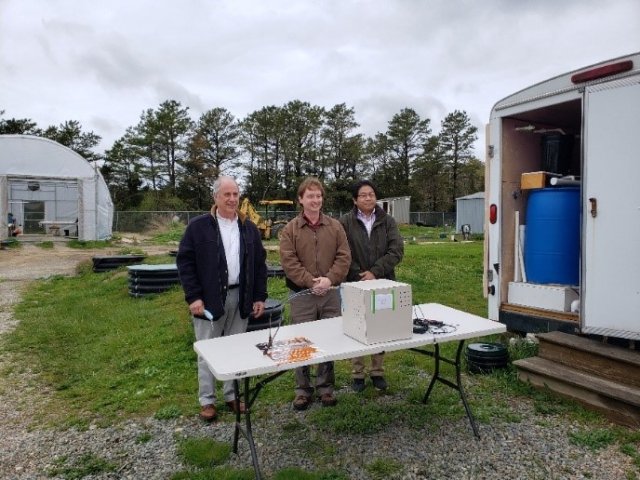From Challenge & Prize Competition to Test Prototype: The Nitrogen Sensor That Could Change Residential Onsite Wastewater Treatment

Published January 19, 2022
More than one in five households in the United States depend on septic or onsite systems to treat their wastewater. These systems provide critical water quality infrastructure, but they usually are not designed to remove nitrogen to the point that sufficiently protects coastal marine ecosystems. As a result, septic systems are known to contribute to eutrophication (excess nutrients), hypoxia (low levels of oxygen), and harmful algal blooms in marine and estuarine waters.
EPA estimates that approximately 2.6 million septic systems in nitrogen-sensitive, coastal watersheds across the country could be good candidates for upgrading to innovative and alternative (I/A) onsite wastewater treatment systems. I/A systems can reduce nitrogen in septic effluent by 50 percent or more through conversion of nitrogen-nitrate into harmless nitrogen gas. However, acceptance and adoption of I/A systems by state and local regulators and homeowners has been slowed by the inability to cost-effectively manufacture and commercialize new systems and assure their long-term performance and effectiveness once they are in the ground.
To address the need to monitor effectiveness of I/A systems, EPA and co-sponsoring organizations launched the Advanced Septic System Nitrogen Sensor Challenge in 2017. The Challenge asked innovators to design nitrogen sensors capable of monitoring the long-term performance of I/A onsite wastewater treatment systems. In November 2019, Dr. Qingzhi Zhu of Stony Brook University and the New York State Center for Clean Water Technology in Stony Brook, NY, won the Challenge’s prize of $50,000 and eligibility for EPA funding for International Organization for Standardization's (ISO) Environmental Technology Verification (ETV) 14034 performance verification testing.
The winning prototype, called the Stony Brook Nitrogen Sensor, provides real-time nitrogen concentration and performance data on I/A systems, eliminating the need for expensive manual sample collection.
“A top performing nitrogen sensor that reliably measures nitrogen concentration in the effluent from I/A systems is an important step in bringing onsite wastewater treatment into the 21st century, and one step closer to achieving parity with the capabilities of centralized wastewater treatment,” said Kristina Heinemann, an EPA Region 2 scientist who has worked on this Challenge and subsequent verification testing since their inception.
In October 2021, after a rigorous six-month testing process, the Stony Brook Nitrogen Sensor met all the performance claims that were part of the ISO ETV 14034 verification test with outstanding accuracy and precision. In some instances, the sensor exceeded the Challenge's and ISO 14034 performance requirements.
The Stony Brook Sensor is still in the prototype phase, and the team is actively working towards manufacturing and commercializing the technology. Once on the market, use of the sensor will increase confidence in the long-term and permanent use of I/A systems. The sensor also presents potential to increase the accuracy of water pollution credits granted to water polluters contributing to stormwater or agricultural runoff in accordance with the Clean Water Act.
EPA staff have been integral in facilitating each step of the sensor development process and take great pride in being part of this innovative initiative.
“It’s been amazing to watch the progression of this project from a stakeholder desire to a tangible sensor,” said Ian Dombroski, a biologist in EPA Region 1. “We’re hopeful that this sensor will lead to the increased use of nitrogen-removing septic systems to combat our coastal nitrogen issues. Climate change will only exacerbate these issues, so scaling up system installation quickly, with the assurance this sensor will bring, is vital to our coastal ecosystems and economies.”
In coastal areas such as Cape Cod, the technology would greatly benefit residents who depend on the health of their waterways for recreation, subsistence fishing, small commercial fishing operations and tourism.
Septic systems are a permanent part of our nation’s wastewater infrastructure, especially for rural, remote, and even suburban areas that have no prospect of connecting to central sewers, or where connection to central sewers is not the environmentally preferable solution. Communities in these areas are often disadvantaged economically. Making upgrades to I/A systems and using a nitrogen sensor could be a step towards improving water quality and advancing environmental justice. The Stony Brook Nitrogen Sensor is one of the new technologies that will allow “unsewered” areas to reach water quality parity with communities supported by centralized wastewater treatment facilities.
Additional Resources
Advanced Septic System Nitrogen Sensor Challenge
Supporting Innovations to Reduce Nitrogen Pollution from Septic Systems
Stony Brook Nitrogen Sensor Verification Statement
ISO 14034 Performance Verification
Long Island Scientist Wins EPA Advanced Septic System Nitrogen Sensor Challenge
